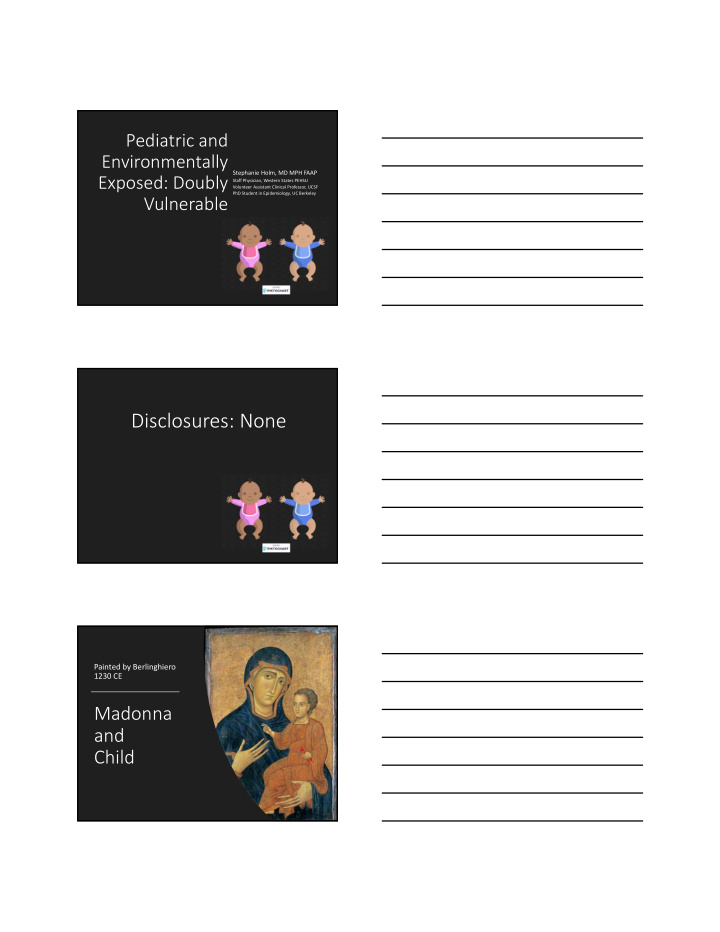



Pediatric and Environmentally Stephanie Holm, MD MPH FAAP Exposed: Doubly Staff Physician, Western States PEHSU Volunteer Assistant Clinical Professor, UCSF PhD Student in Epidemiology, UC Berkeley Vulnerable Disclosures: None Painted by Berlinghiero 1230 CE Madonna and Child
Children are NOT small adults! HOWEVER Children are human!
Why are Children More Vulnerable? 1. Behaviors and Preferences that Increase Exposure 2. Differences in Physiology that increase Dose 3. Unique Windows of Development Behaviors and Preferences that Increase Exposure • Mouthing objects‐increased ingestion • Hands contacting the floor‐increased ingestion • Inability to assess risk • Often have higher exercise time relative to adults PBDE Exposure • Brominated Hydrocarbon flame retardants • Common in foam products until 2013 • Broken down foam settles in dust; high levels remain even in areas where it was phased out • Associated with neurobehavioral , liver and thyroid effects in animal studies • In children, associated with deficits in attention and executive functioning, possibly with leukemia
Behaviors and Preferences that Increase Exposure‐ Diet • Up to 4‐6 months of age‐ formula/breastmilk only • Mercury in breastmilk • Clean water for formula • Minimizing clear plastics • Small children often eat limited fruits and veggies • often ones with high pesticide exposures Arsenic • Rice cereal was often recommended as a first food historically • Apple products (apple sauce, apple juice also high in arsenic) • Also of particular concern for older children with restricted diets (such as gluten‐free) Behaviors and Preferences that Increase Exposure‐Surroundings • More time at home • Airborne‐ radon, PM, second‐hand tobacco, aerosols from cleaning products • Dust‐ lead, PBDEs • Young children‐ care settings (either other homes or Early Care and Education settings) • VOCs in arts/craft supplies • Disinfectants • Older Children‐ School, activities • Teens‐ School, activities, workplaces, hobbies
Early Care and Education • One of the few locations where disinfectant use is mandated with children present • Bleach and quaternary ammonia products are asthmagens Differences in Physiology that Increase Dose • Rapid growth with higher metabolic rate • Eat more food • Drink more water • Breathe more air • Larger Body surface to mass ratio • Longer remaining life‐expectancy • Breathing zone closer to the floor • Some enzymes for processing/clearing toxicants are still developing Air Pollutants • Per kg of body weight, a one‐year old has a minute ventilation that is TWICE that of an adult. • Both short and long‐term ozone exposure is related to decrements in FEV1 in children, but less reliably in adults • More frequent respiratory infections (otitis, pneumonia, etc) • Risk in‐utero as well
https://envhealthcenters.usc.edu/infographics/infographic‐cleaner‐air‐healthier‐lungs Windows of Susceptibility • Small molecules and fat soluble molecules can cross the placenta • Because of rapid growth, many dividing cells • Lead exposure in infancy/toddlerhood particularly problematic • Adolescents have rapid gonadal development Adverse Childhood Events (ACEs) • Associated with a spectrum of health effects across the life course (including cancer, heart disease, diabetes, respiratory disease) • Children exposed to violence and air pollution are at increased risk of developing asthma • Early life stress thought to be able to reprogram the HPA axis • Some studies have found strongest effects for ACEs in early childhood
Taking a Pediatric Environmental Health History • Home • School • Workplace (teens) • Community • Tobacco • Water Source • Diet • Sun • Take‐Home Exposures Pediatric Environmental Health Toolkit peht.ucsf.edu Optimized for Mobile! For further education on environmental health through the lifecourse (with CME available!)
Western States PEHSU wspehsu.ucsf.edu Don’t forget about the benefits of childhood!
When you grow up, people stop asking what your favorite dinosaur is. It’s like they don’t even care. References • Agency for Toxic Substances and Disease Registry: Principles of Pediatric Environmental Health. What are Factors Affecting Children’s Susceptibility to Exposures? https://www.atsdr.cdc.gov/csem/csem.asp?csem=27&po=6 Atlanta, GA 2013 • Pediatric Environmental Health, 3 rd Edition. Edited by Ruth A. Etzel and Sophie J. Balk. Itasca, IL, American Academy of Pediatrics, 2011 • Pediatric Environmental Health Specialty Units. https://www.pehsu.net/ Washington, DC 2019 • Western States Pediatric Environmental Health : Pediatric Environmental Health Toolkit. https://peht.ucsf.edu/index.php San Francisco, CA 2016 • American Association of Poison Control Centers. https://aapcc.org Alexandria, VA 2017 • Miller MD and Marty MA: Childhood ‐ A Time Period Uniquely Vulnerable to Environmental Exposures in The Praeger Handbook of Environmental Health, edited by Robert H. Friis, Santa Barbara, CA, ABC‐CLIO LLC, 2012, p 203 Children should be considered differently than adults because: A. They have a higher metabolic rate B. They have a higher surface area to mass ratio C. They have particular windows of susceptibility D. All of the above
Adverse Childhood Experiences: A. Do not affect adult health outcomes B. Do not have interactive effects with environmental exposures C. Are stressful or traumatic events occurring in childhood Minute Ventilation by weight in a 1 year old is roughly __ times that in adults (Adults are roughly 0.1L/kg) A. 0.5 B. 1 C. 2 D. 4 Diplodocus carnegii Statue in Pittsburgh, PA Photograph by Wally Gobetz, used under CC license: https://creativecommons.org/licenses/by‐nc‐nd/2.0/
@dippy_the_dino: https://twitter.com/dippy_the_dino?lang=en
Recommend
More recommend